SEO
A Call-To-Action Guide For Businesses

The CTA (call-to-action) is a make-or-break moment in your content strategy and lead generation goals.
Therefore, it is a critical copywriting component and essential in your B2B (business-to-business) marketing content and webpages.
Plenty of information is available if you want to learn about B2C CTAs.
However, B2B CTAs often lack resources for inspiration – and many brands in the industry don’t take the proper care to make them engaging, resorting to endless “learn more” and “book demo” CTAs.
In this guide, you will learn how to write a compelling B2B CTA, with four best practices to infuse into your copywriting and 10 examples from major brands that work to engage prospects and drive clicks.
4 Best Practices For Creating A B2B CTA
General guidelines can help when writing CTAs – whether you’re faced with a blank document, or looking for that last element needed to finalize a project and meet the deadline.
These four best practices will inspire your writing efforts and help you decide what to do when a B2B CTA is required.
Deliver Value To The Buying Committee
In contrast to B2C consumers, a buying committee often decides on B2B purchases. These must not only appease stakeholders when bringing a solution in-house but are also composed of members with differing priorities and concerns.
Thus, strategies that work well with B2C CTAs, such as “Fear Of Missing Out” (FOMO) and urgency, can come across as “clickbaity” or appear desperate in B2B. Value (and trust) must be proven for the investment to be approved.
Therefore, tailor your CTAs to your audience and focus on promoting the unique value of your products, first and foremost.
Utilizing marketing segmentation data and personalizing CTAs for buyer personas works even better to ensure your campaign’s selected values resonate with your target accounts.
Be Conversational, To A Point
In B2B, brands sometimes overdo the jargon and formality.
And while brand consistency and voice are important, it is crucial to be relatable and conversational in your CTAs.
For example, an SDR (sales development representative) that says, “Let’s book a time for coffee and chat,” is more approachable than “click here to book a sales meeting.”
Being to the point, however, is also important. As mentioned previously, you need to demonstrate the unique value of your CTAs.
Prospects are often short on time and won’t click if the value isn’t apparent.
Spark Curiosity By Addressing The Implications
A common copywriting technique is to address the implications of a problem, yet not deliver the solution on a silver platter.
In other words: Mention what can go wrong for the prospect, but reinforce that they need to click on the CTA to discover exactly how they can solve their challenges.
Like “cliffhangers” in literature and TV series, this technique can increase your click-through rate – but you must deliver on your promise.
Nothing disappoints more than a cliffhanger that doesn’t meet expectations.
A/B Test Your Copy And Design
Testing is key to determining which CTAs work for your audience.
You can always guess what will work best, but with A/B tests, you’ll know what is truly driving clicks.
It’s important to test copy, colors, design, and the placements of your CTAs, as well as additional elements such as surrounding imagery and copy leading up to the CTA.
Make sure to test only one element at a time so that you can associate the increase/decrease in clicks with a specific adjustment.
10 Examples Of Inspirational B2B CTAs
With these four best practices in mind, here are 10 examples of B2B CTAs that drive clicks.
They deliver value and stand out from the surrounding copy on their webpages.
1. “See All Plays” By Atlassian
Atlassian, a software tools platform, has this CTA on its homepage to invite visitors to check its team playbooks.
The copy is the following:
- Headline: Our Practices
- Subtitle: Great teamwork requires more than just great tools. Check out our proven methods, guides, and exercises that help make work better, and people happier.
- CTA: See all plays
The CTA is followed by a breakdown of four team playbooks by Atlassian, so the visitor has an overview of what they will see if they click.
This CTA works well because it not only presents enough information for the prospect to understand the value (methods, guides, and exercises to build great teamwork), but teases them with four breakdowns of what they will find in the plays.
Without the breakdown, the word “plays” would be vague and not draw attention.
Therefore, all elements combined spark curiosity and invite the reader to the next page, where they can read the instructions for all 30 playbooks.
2. “Get Started With eSignature” By DocuSign
 Screenshot from DocuSign, July 2022
Screenshot from DocuSign, July 2022The above example is a CTA that pairs well with its headline and subtitle:
- Headline: The way the world agrees
- Subtitle: More than a million customers and a billion users trust DocuSign with their critical and essential agreements.
- CTA: Get Started with eSignature
Paired with the social proof (“million customers” and “billion users”) and the wordplay headline (which alludes to the act of signing papers with mutual agreement), DocuSign entices the user to click the CTA and see what’s offered.
It leads directly to a landing page for a 30-day free trial that gets right to the point and delivers what DocuSign’s audience desires (to sign documents electronically).
3. “Go Big With Pax8” By Pax8
 Screenshot from Pax8, July 2022
Screenshot from Pax8, July 2022Cloud marketplace platform Pax8 does a spin on the regular “learn more” CTA with this intriguing line. For full context, it has a header and subheader before it:
- Headline: Where Business Goes Big
- Subtitle: Join the cloud marketplace that unlocks a universe of possibility.
- CTA: Go Big With Pax8
Plastered on a starry background with abstract imagery, the CTA works well to pique interest in what “going big” means. It links to Pax8’s “Why Pax8” page, which briefly explains its services and provides social proof with ROI numbers for its partners—indeed, what most expect when “going big.”
4. “Explore The Process” By project44
 Screenshot from project44, July 2022
Screenshot from project44, July 2022Logistics visibility platform project44 invites the user to discover the inner workings of its product with this CTA:
- Headline: GETTING STARTED Easy Implementation with Help at Every Step
- Subtitle: Our dedicated team of supply chain visibility experts are eager to help you implement project44 and get your carriers onboarded quickly.
- CTA: EXPLORE THE PROCESS
In an industry where time is of the essence, and major supply chain issues can arise from the smallest of delays, project44 appeases objections with onboarding by featuring a step-by-step rundown of what happens when acquiring the product.
There’s also a CTA to a demo so the prospect can see how the platform works and convert to a lead.
5. “See All Success Stories” By BlackLine
 Screenshot from BlackLine, July 2022
Screenshot from BlackLine, July 2022Accounting platform BlackLine showcases four client testimonials for social proof at the end of its Financial Close Management solution page:
Using “Success Stories” for the CTA rather than the regular “case studies” adds value to the point BlackLine is making with the four testimonials featured above it: that clients obtain provable, quantifiable ROI by utilizing the platform successfully.
It adds weight to the numbers and entices the user to click to learn about the success of these clients.
6. “See All 11 Reasons” By Apple At Work
 Screenshot from Apple, July 2022
Screenshot from Apple, July 2022Apple’s dedicated business page has this CTA under its Mac product to invite users to a page with plenty of eye candy and engaging language about why the Mac is better than other laptops in a similar price range.
- Headline: Mac
- Subtitle: Magic happens on Mac. Game-changing performance, simple IT, and excellent value are just some of the reasons Mac means business.
- CTA: See all 11 reasons
The odd number (11 instead of 10) calls attention, along with the fact that it is the only “list CTA” on the page, while most use the traditional “learn more” format.
Also, since Apple designed a unique page with illustrations and fun copywriting for showcasing the 11 reasons, it delivers on the promise of why the user should pick Mac.
7. “Learn More About Our Purpose” By Caterpillar
 Screenshot from Caterpillar, July 2022
Screenshot from Caterpillar, July 2022Manufacturer and construction company Caterpillar features this CTA on its Strategy & Purpose page for people to deep dive into the company’s purpose.
The copy is as follows:
- Headline: WHY WE DO IT
- Subtitle: For over 95 years, our products and services have helped improve the lives of people around the world(…)
- CTA: LEARN ABOUT OUR PURPOSE
This CTA works well because it aligns with the page’s name and drives the user to learn more after reading the copy under “Why we do it,” in a way that a simple “Learn more” wouldn’t.
In other words, the keyword “purpose” adds value to the CTA, making it more click-worthy for users who wish to learn more about the brand’s goals.
8. “Find Out How” By Honeywell
 Screenshot from Honeywell, July 2022
Screenshot from Honeywell, July 2022Honeywell – the conglomerate in aerospace, building, and performance materials – has this CTA on its homepage to invite users to its The Future page.
- Headline: The Future Is What We Make It
- Subtitle: Back to work. Back to play. Back to travel. Let’s tackle the world’s new challenges together.
- CTA: FIND OUT HOW
A video accompanies the CTA and copy in the background of flying cars, skyscrapers, factories, and production lines, which draws attention to “the future” Honeywell is envisioning.
These elements and the CTA engage the user to discover what this future is about.
9. “Ride Along” By Cummins
 Screenshot from Cummins, July 2022
Screenshot from Cummins, July 2022Engine and power corporation Cummins has this CTA on its Bus industry page to read a press release on an electric bus powered by its battery:
- Headline: Blue Bird Takes Flight
- Subtitle: An Indiana district received a Blue Bird electric school bus, powered by our PowerDrive 7000EV battery electric powertrain.
- CTA: RIDE ALONG
The “ride along,” with its storytelling element CTA, is inviting. Its double meaning encourages the reader to connect with the story of riding on the bus to learn about this technology.
True to the description, the press release tells the news of how a school in Indiana, U.S., acquired the bus as an environmentally-friendly solution.
1.0 “Experience Rosa Robotics” By Zimmer Biomet
 Screenshot from Zimmer Biomet, July 2022
Screenshot from Zimmer Biomet, July 2022Medical device company Zimmer Biomet has this CTA on its homepage for users to learn more about its Rosa Robotics line:
- Headline: ROSA® Robotics
- Subtitle: ROSA® Robotics is a multi-application platform that utilizes Zimmer Biomet’s leading implants and data technologies to redefine robotics by providing real-time insights to optimize outcomes.
- CTA: Experience ROSA® Robotics
Using the word “experience” – like CTA #9 above – leverages storytelling to connect with the imagination and curiosity of the user, as if they will take a deep dive into the inner workings of these robots.
It leads to a dedicated page with four robots for different uses (knee, partial knee, hip, and neurosurgery).
This CTA is a simple example of how exchanging typical “learn more” language with another action verb (such as experience) can make it more engaging and entice more clicks.
Final Takeaways
Based on the 10 examples of B2B CTAs above, here are my final takeaways on what works to make your copy stand out in this industry.
Infuse Your Unique Value Proposition And Branding In The CTA Copy
Some examples on this list not only state in the CTA the value it offers, but also a keyword associated with the brand and the action encouraged.
That’s the case in the “Go Big with Pax8” example.
It reiterates a theme used elsewhere on the website (going big) and adds the brand name in the CTA to associate both concepts.
You can inspire yourself with this example by adding brand keywords on the CTAs that lead to your product pages.
Replace “Learn More” And Other Generic CTAs With Interesting Action Verbs
While simple often works best, most B2B brands play it safe with their copywriting by utilizing “learn more” for their product CTAs.
This quickly turns stale, and your prospects will ignore the CTAs unless the headline is interesting enough.
However, if you use a different verb or turn of phrase (such as the “ride along” CTA by Cummins, example #9), then you will reel in attention and get more clicks.
Think how many products have something much more interesting to engage prospects rather than a simple “learn more.”
Action verbs help to connect the prospect to the benefits of a product or motivate them to actively take the next step.
Make The CTA An Invitation To A Story/Experience
The goal of any CTA is to muster an action – and inviting the prospect to enjoy a storytelling experience with your brand is engaging since it resonates with emotion during crucial decision-making.
It not only “breaks the ice” but makes your prospect attach positive feelings to your products, especially if they clicked on your CTA and enjoyed their experience.
Therefore, instead of saying “Read X,” why not, “Find Out How,” like Honeywell does in example #8?
More resources:
Featured Image: Motortion Films/Shutterstock
SEO
Measuring Content Impact Across The Customer Journey
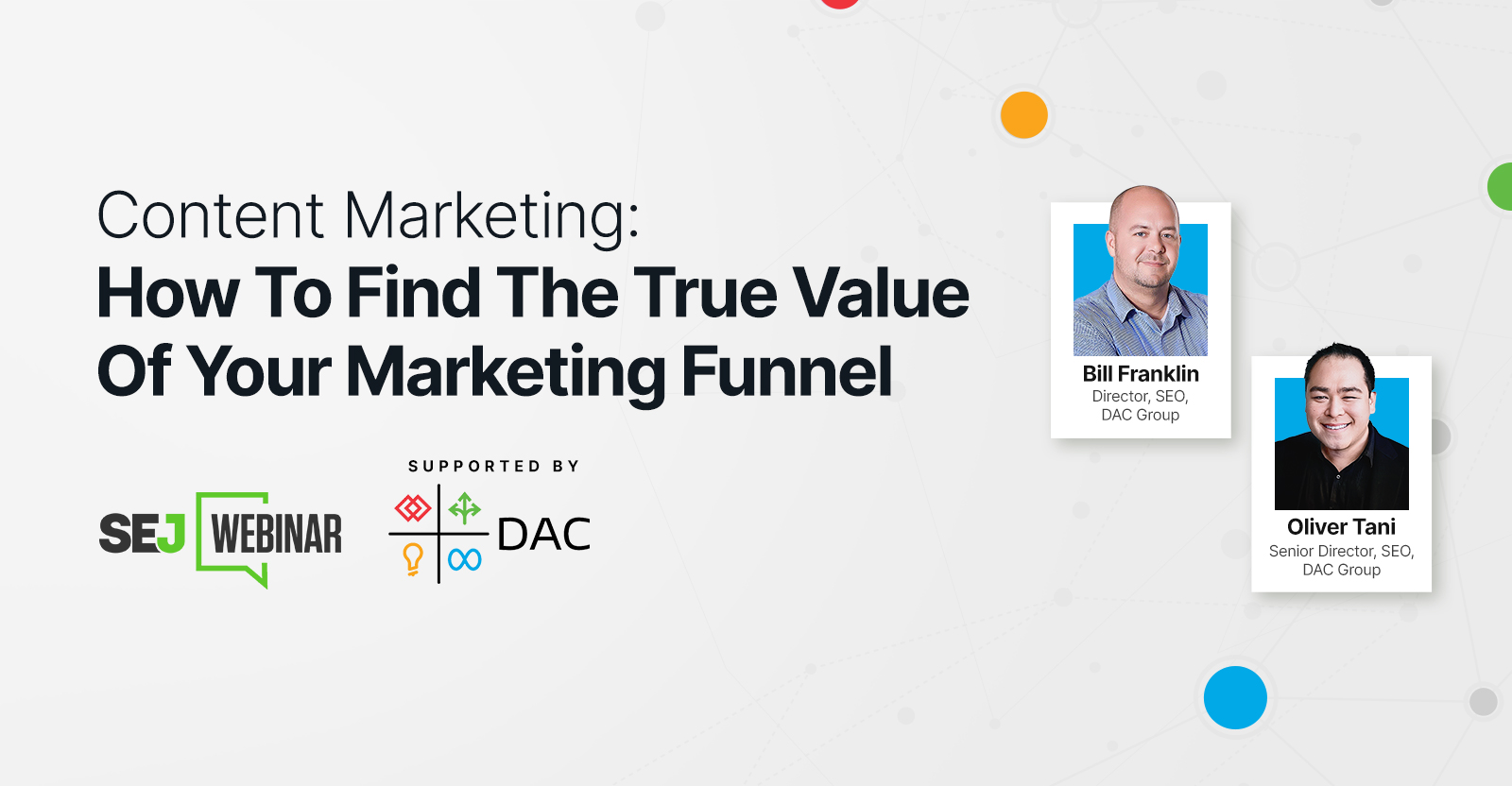
Understanding the impact of your content at every touchpoint of the customer journey is essential – but that’s easier said than done. From attracting potential leads to nurturing them into loyal customers, there are many touchpoints to look into.
So how do you identify and take advantage of these opportunities for growth?
Watch this on-demand webinar and learn a comprehensive approach for measuring the value of your content initiatives, so you can optimize resource allocation for maximum impact.
You’ll learn:
- Fresh methods for measuring your content’s impact.
- Fascinating insights using first-touch attribution, and how it differs from the usual last-touch perspective.
- Ways to persuade decision-makers to invest in more content by showcasing its value convincingly.
With Bill Franklin and Oliver Tani of DAC Group, we unravel the nuances of attribution modeling, emphasizing the significance of layering first-touch and last-touch attribution within your measurement strategy.
Check out these insights to help you craft compelling content tailored to each stage, using an approach rooted in first-hand experience to ensure your content resonates.
Whether you’re a seasoned marketer or new to content measurement, this webinar promises valuable insights and actionable tactics to elevate your SEO game and optimize your content initiatives for success.
View the slides below or check out the full webinar for all the details.
SEO
How to Find and Use Competitor Keywords

Competitor keywords are the keywords your rivals rank for in Google’s search results. They may rank organically or pay for Google Ads to rank in the paid results.
Knowing your competitors’ keywords is the easiest form of keyword research. If your competitors rank for or target particular keywords, it might be worth it for you to target them, too.
There is no way to see your competitors’ keywords without a tool like Ahrefs, which has a database of keywords and the sites that rank for them. As far as we know, Ahrefs has the biggest database of these keywords.
How to find all the keywords your competitor ranks for
- Go to Ahrefs’ Site Explorer
- Enter your competitor’s domain
- Go to the Organic keywords report
The report is sorted by traffic to show you the keywords sending your competitor the most visits. For example, Mailchimp gets most of its organic traffic from the keyword “mailchimp.”


Since you’re unlikely to rank for your competitor’s brand, you might want to exclude branded keywords from the report. You can do this by adding a Keyword > Doesn’t contain filter. In this example, we’ll filter out keywords containing “mailchimp” or any potential misspellings:
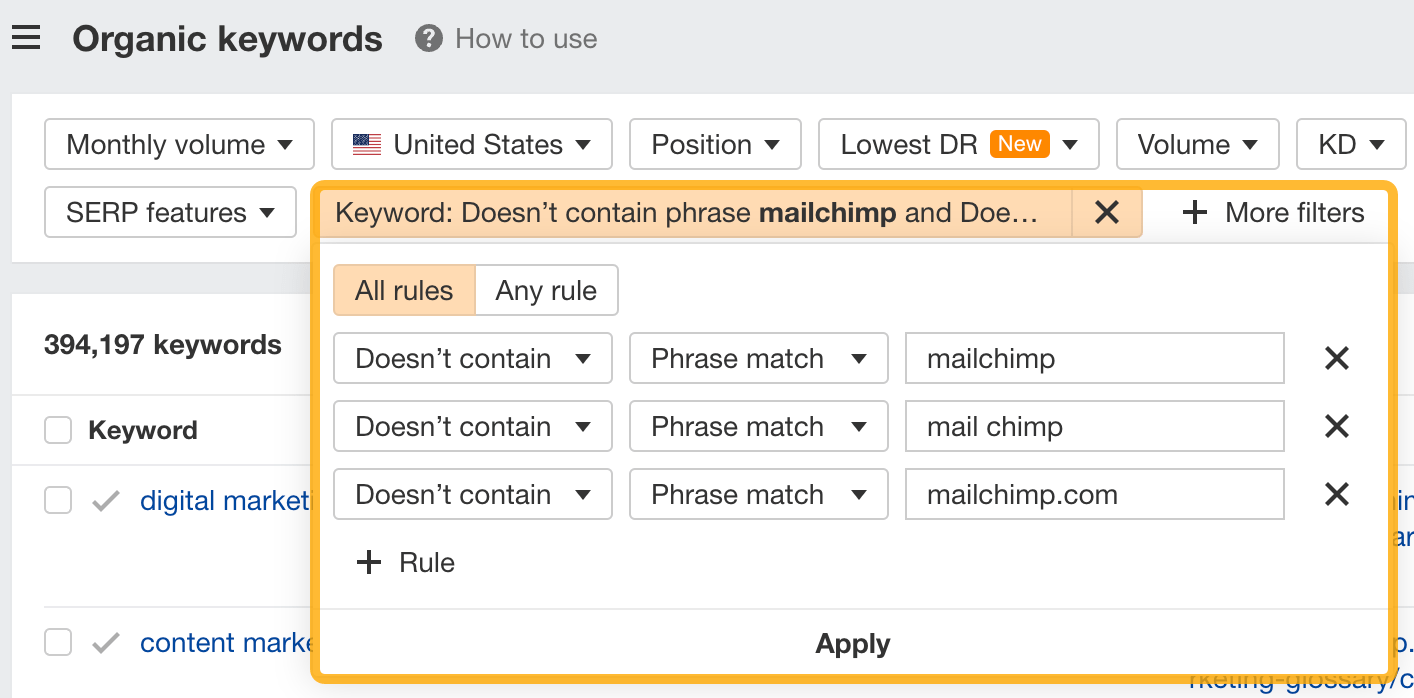

If you’re a new brand competing with one that’s established, you might also want to look for popular low-difficulty keywords. You can do this by setting the Volume filter to a minimum of 500 and the KD filter to a maximum of 10.


How to find keywords your competitor ranks for, but you don’t
- Go to Competitive Analysis
- Enter your domain in the This target doesn’t rank for section
- Enter your competitor’s domain in the But these competitors do section


Hit “Show keyword opportunities,” and you’ll see all the keywords your competitor ranks for, but you don’t.


You can also add a Volume and KD filter to find popular, low-difficulty keywords in this report.


How to find keywords multiple competitors rank for, but you don’t
- Go to Competitive Analysis
- Enter your domain in the This target doesn’t rank for section
- Enter the domains of multiple competitors in the But these competitors do section
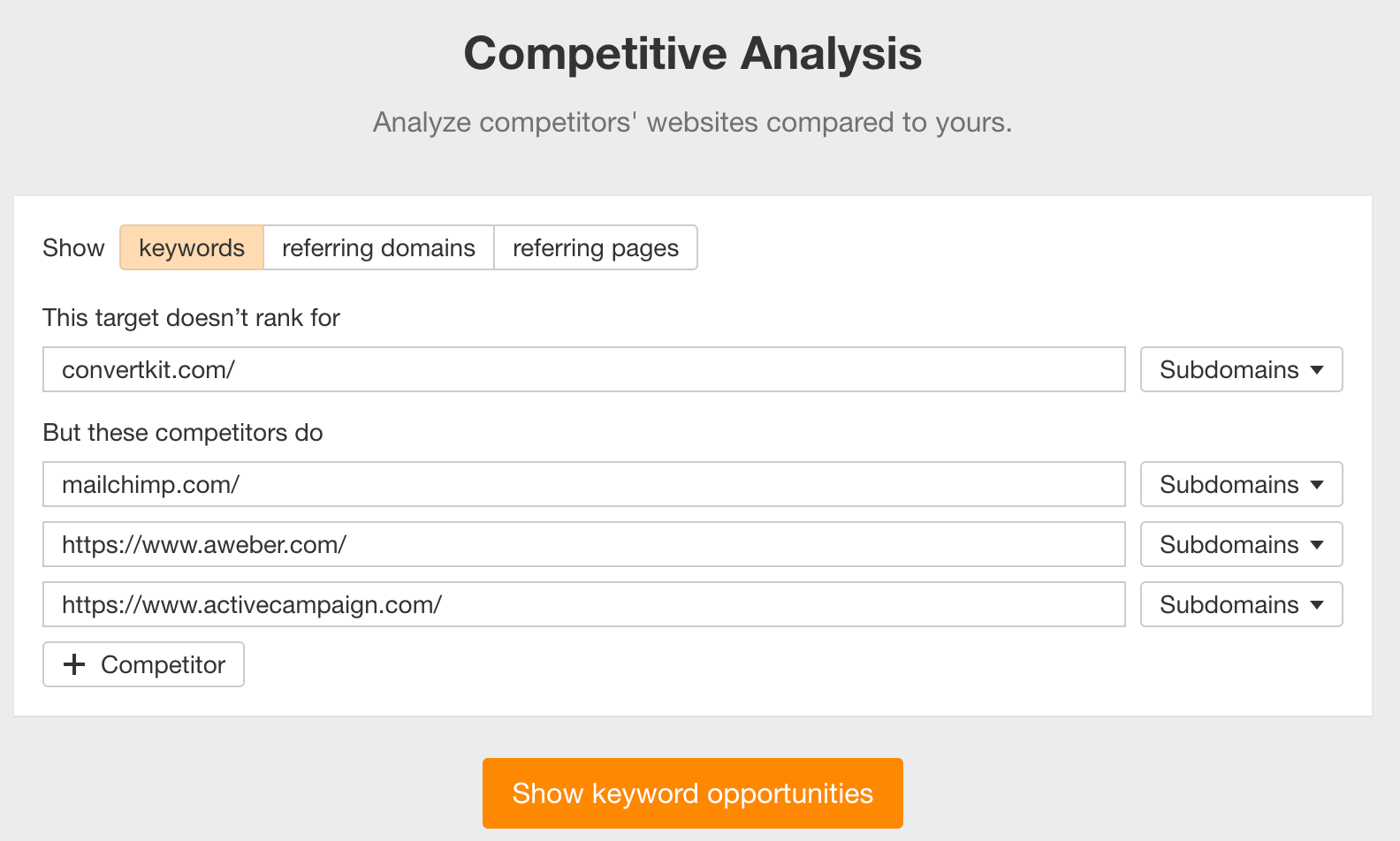

You’ll see all the keywords that at least one of these competitors ranks for, but you don’t.


You can also narrow the list down to keywords that all competitors rank for. Click on the Competitors’ positions filter and choose All 3 competitors:


- Go to Ahrefs’ Site Explorer
- Enter your competitor’s domain
- Go to the Paid keywords report
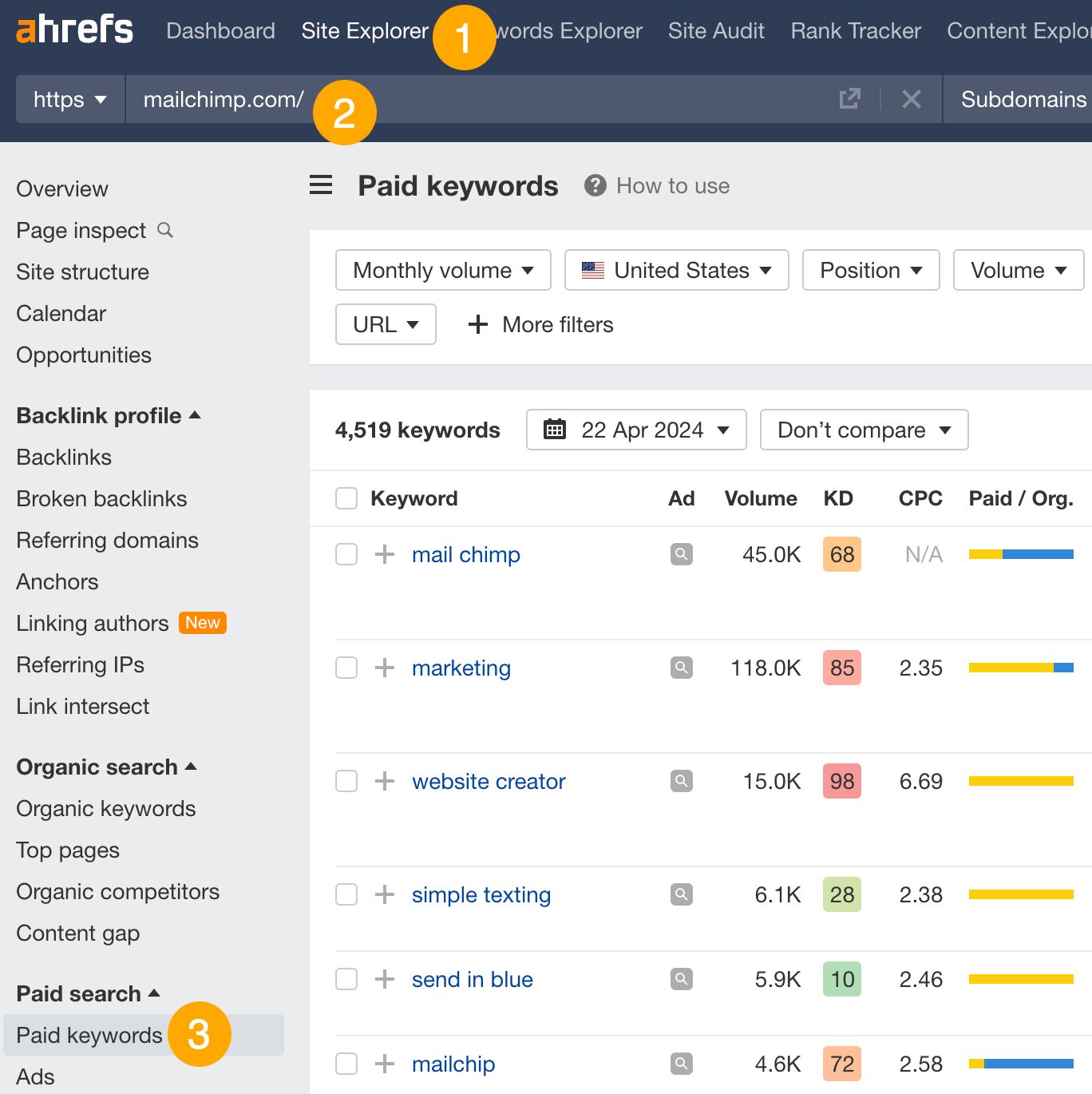

This report shows you the keywords your competitors are targeting via Google Ads.
Since your competitor is paying for traffic from these keywords, it may indicate that they’re profitable for them—and could be for you, too.
You know what keywords your competitors are ranking for or bidding on. But what do you do with them? There are basically three options.
1. Create pages to target these keywords
You can only rank for keywords if you have content about them. So, the most straightforward thing you can do for competitors’ keywords you want to rank for is to create pages to target them.
However, before you do this, it’s worth clustering your competitor’s keywords by Parent Topic. This will group keywords that mean the same or similar things so you can target them all with one page.
Here’s how to do that:
- Export your competitor’s keywords, either from the Organic Keywords or Content Gap report
- Paste them into Keywords Explorer
- Click the “Clusters by Parent Topic” tab


For example, MailChimp ranks for keywords like “what is digital marketing” and “digital marketing definition.” These and many others get clustered under the Parent Topic of “digital marketing” because people searching for them are all looking for the same thing: a definition of digital marketing. You only need to create one page to potentially rank for all these keywords.
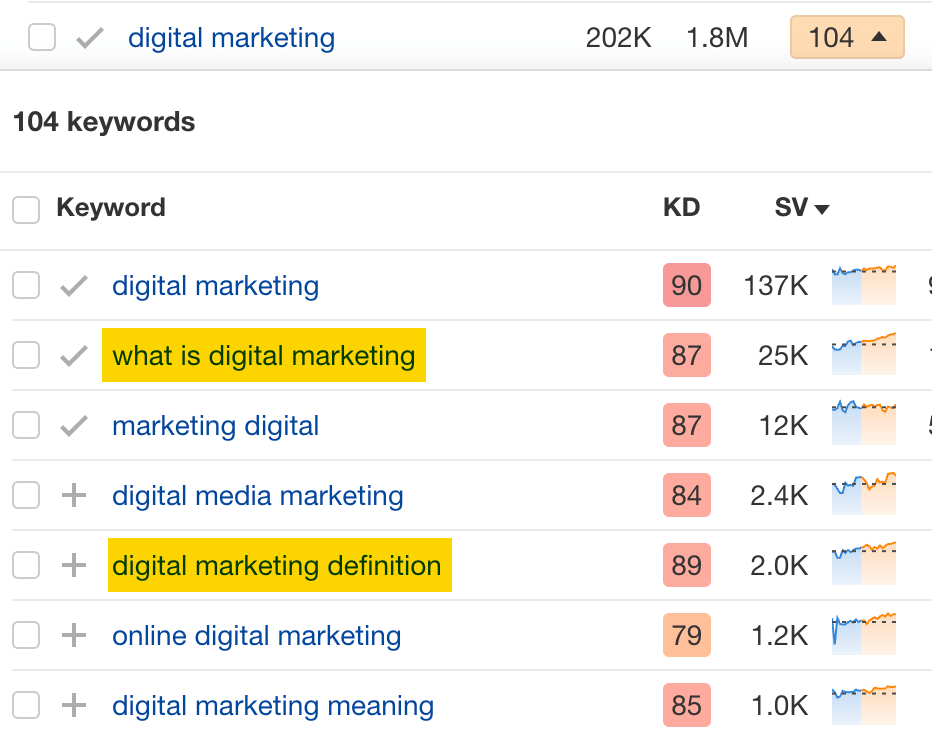

2. Optimize existing content by filling subtopics
You don’t always need to create new content to rank for competitors’ keywords. Sometimes, you can optimize the content you already have to rank for them.
How do you know which keywords you can do this for? Try this:
- Export your competitor’s keywords
- Paste them into Keywords Explorer
- Click the “Clusters by Parent Topic” tab
- Look for Parent Topics you already have content about
For example, if we analyze our competitor, we can see that seven keywords they rank for fall under the Parent Topic of “press release template.”


If we search our site, we see that we already have a page about this topic.


If we click the caret and check the keywords in the cluster, we see keywords like “press release example” and “press release format.”
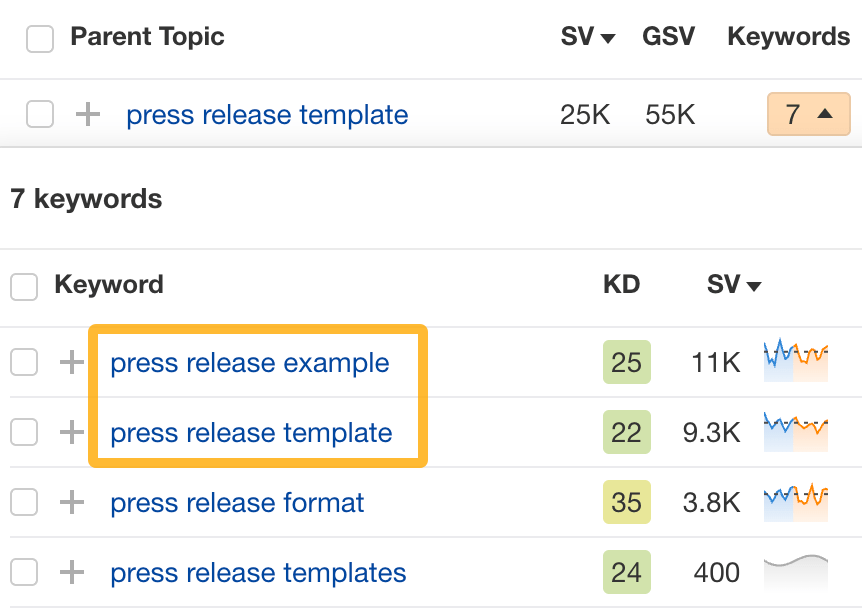

To rank for the keywords in the cluster, we can probably optimize the page we already have by adding sections about the subtopics of “press release examples” and “press release format.”
3. Target these keywords with Google Ads
Paid keywords are the simplest—look through the report and see if there are any relevant keywords you might want to target, too.
For example, Mailchimp is bidding for the keyword “how to create a newsletter.”


If you’re ConvertKit, you may also want to target this keyword since it’s relevant.
If you decide to target the same keyword via Google Ads, you can hover over the magnifying glass to see the ads your competitor is using.
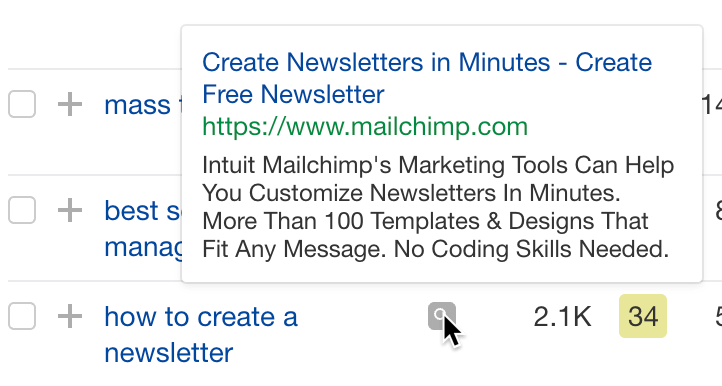

You can also see the landing page your competitor directs ad traffic to under the URL column.


Learn more
Check out more tutorials on how to do competitor keyword analysis:
SEO
Google Confirms Links Are Not That Important

Google’s Gary Illyes confirmed at a recent search marketing conference that Google needs very few links, adding to the growing body of evidence that publishers need to focus on other factors. Gary tweeted confirmation that he indeed say those words.
Background Of Links For Ranking
Links were discovered in the late 1990’s to be a good signal for search engines to use for validating how authoritative a website is and then Google discovered soon after that anchor text could be used to provide semantic signals about what a webpage was about.
One of the most important research papers was Authoritative Sources in a Hyperlinked Environment by Jon M. Kleinberg, published around 1998 (link to research paper at the end of the article). The main discovery of this research paper is that there is too many web pages and there was no objective way to filter search results for quality in order to rank web pages for a subjective idea of relevance.
The author of the research paper discovered that links could be used as an objective filter for authoritativeness.
Kleinberg wrote:
“To provide effective search methods under these conditions, one needs a way to filter, from among a huge collection of relevant pages, a small set of the most “authoritative” or ‘definitive’ ones.”
This is the most influential research paper on links because it kick-started more research on ways to use links beyond as an authority metric but as a subjective metric for relevance.
Objective is something factual. Subjective is something that’s closer to an opinion. The founders of Google discovered how to use the subjective opinions of the Internet as a relevance metric for what to rank in the search results.
What Larry Page and Sergey Brin discovered and shared in their research paper (The Anatomy of a Large-Scale Hypertextual Web Search Engine – link at end of this article) was that it was possible to harness the power of anchor text to determine the subjective opinion of relevance from actual humans. It was essentially crowdsourcing the opinions of millions of website expressed through the link structure between each webpage.
What Did Gary Illyes Say About Links In 2024?
At a recent search conference in Bulgaria, Google’s Gary Illyes made a comment about how Google doesn’t really need that many links and how Google has made links less important.
Patrick Stox tweeted about what he heard at the search conference:
” ‘We need very few links to rank pages… Over the years we’ve made links less important.’ @methode #serpconf2024″
Google’s Gary Illyes tweeted a confirmation of that statement:
“I shouldn’t have said that… I definitely shouldn’t have said that”
Why Links Matter Less
The initial state of anchor text when Google first used links for ranking purposes was absolutely non-spammy, which is why it was so useful. Hyperlinks were primarily used as a way to send traffic from one website to another website.
But by 2004 or 2005 Google was using statistical analysis to detect manipulated links, then around 2004 “powered-by” links in website footers stopped passing anchor text value, and by 2006 links close to the words “advertising” stopped passing link value, links from directories stopped passing ranking value and by 2012 Google deployed a massive link algorithm called Penguin that destroyed the rankings of likely millions of websites, many of which were using guest posting.
The link signal eventually became so bad that Google decided in 2019 to selectively use nofollow links for ranking purposes. Google’s Gary Illyes confirmed that the change to nofollow was made because of the link signal.
Google Explicitly Confirms That Links Matter Less
In 2023 Google’s Gary Illyes shared at a PubCon Austin that links were not even in the top 3 of ranking factors. Then in March 2024, coinciding with the March 2024 Core Algorithm Update, Google updated their spam policies documentation to downplay the importance of links for ranking purposes.
The documentation previously said:
“Google uses links as an important factor in determining the relevancy of web pages.”
The update to the documentation that mentioned links was updated to remove the word important.
Links are not just listed as just another factor:
“Google uses links as a factor in determining the relevancy of web pages.”
At the beginning of April Google’s John Mueller advised that there are more useful SEO activities to engage on than links.
Mueller explained:
“There are more important things for websites nowadays, and over-focusing on links will often result in you wasting your time doing things that don’t make your website better overall”
Finally, Gary Illyes explicitly said that Google needs very few links to rank webpages and confirmed it.
I shouldn’t have said that… I definitely shouldn’t have said that
— Gary 鯨理/경리 Illyes (so official, trust me) (@methode) April 19, 2024
Why Google Doesn’t Need Links
The reason why Google doesn’t need many links is likely because of the extent of AI and natural language undertanding that Google uses in their algorithms. Google must be highly confident in its algorithm to be able to explicitly say that they don’t need it.
Way back when Google implemented the nofollow into the algorithm there were many link builders who sold comment spam links who continued to lie that comment spam still worked. As someone who started link building at the very beginning of modern SEO (I was the moderator of the link building forum at the #1 SEO forum of that time), I can say with confidence that links have stopped playing much of a role in rankings beginning several years ago, which is why I stopped about five or six years ago.
Read the research papers
Authoritative Sources in a Hyperlinked Environment – Jon M. Kleinberg (PDF)
The Anatomy of a Large-Scale Hypertextual Web Search Engine
Featured Image by Shutterstock/RYO Alexandre
-

 PPC4 days ago
PPC4 days ago19 Best SEO Tools in 2024 (For Every Use Case)
-

 MARKETING7 days ago
MARKETING7 days agoWill Google Buy HubSpot? | Content Marketing Institute
-
SEARCHENGINES7 days ago
Daily Search Forum Recap: April 16, 2024
-

 SEO7 days ago
SEO7 days agoGoogle Clarifies Vacation Rental Structured Data
-

 MARKETING6 days ago
MARKETING6 days agoStreamlining Processes for Increased Efficiency and Results
-
SEARCHENGINES6 days ago
Daily Search Forum Recap: April 17, 2024
-

 SEO6 days ago
SEO6 days agoAn In-Depth Guide And Best Practices For Mobile SEO
-

 PPC6 days ago
PPC6 days ago97 Marvelous May Content Ideas for Blog Posts, Videos, & More















You must be logged in to post a comment Login